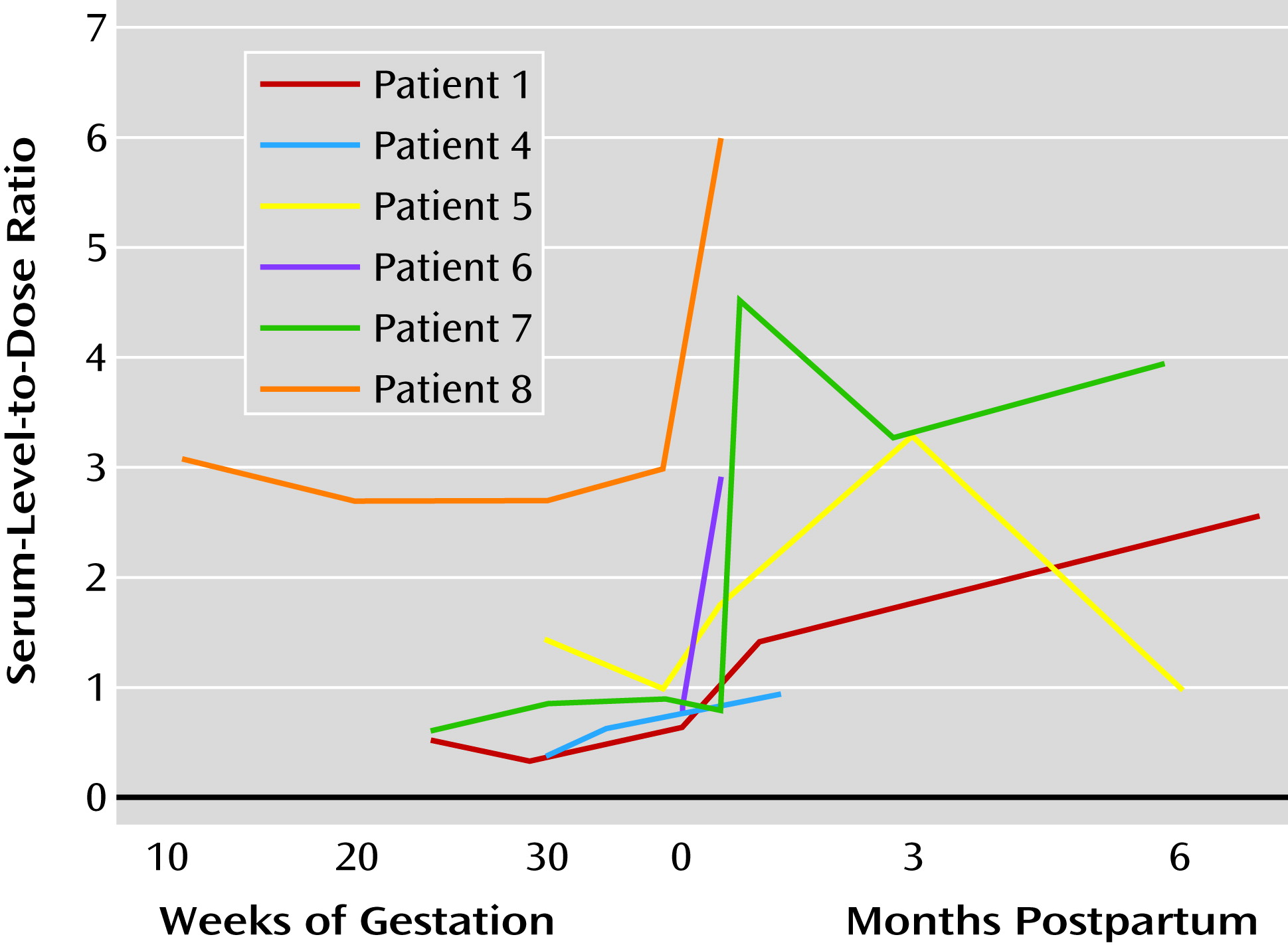Lamotrigine Dosing for Pregnant Patients With Bipolar Disorder
Abstract
Objective
Method
Results
Conclusions
Pharmacokinetics
Pharmacokinetics in Pregnancy
Postpartum Pharmacokinetics
Transplacental Transfer to the Fetus
Lamotrigine and Breast-Feeding
Method
Assessments
Infant Outcomes
Lamotrigine Serum Analysis
Results
Sample Characteristics
| Patient Number | Age (Years) | Education | Marital Status | Gestational Age at Delivery (Weeks) | Birth Weight | Bayley Scales of Infant Development | Concomitant Medications | |||||
|---|---|---|---|---|---|---|---|---|---|---|---|---|
| Weight (g) | Percentile | Infant Sex | MDI Score | Month | PDI Score | Month | ||||||
| 1 | 31 | Some college | Married | 37 | 3,572 | 54 | Male | 87 | 12 | 105 | 12 | Paliperidone, bupropion, quetiapine, prenatal vitamins, folic acid |
| 2 | 30 | Some college | Single | 37 | 3,543 | 52 | Male | 99 | 3 | 88 | 3 | Aripiprazole, carbamazepine, omega-3, prenatal vitamins |
| 3 | 25 | Some college | Divorced | 39 | n/a | n/a | n/a | n/a | n/a | Prenatal vitamins, magnesium supplement | ||
| 4 | 33 | Some college | Married | 40 | 2,835 | 33 | Female | 91 | 12 | 95 | 12 | Risperidone, alprazolam |
| 5 | 30 | College graduate | Single | 37 | 2,495 | 5 | Female | 103 | 12 | 114 | 12 | Carbamazepine, topiramate, lithium, paroxetine, sertraline, clonazepam, low-dosage estrogen birth control pill |
| 6 | 31 | High school graduate (GED) | Single | 39 | 3,685 | 62 | Female | 89 | 12 | 72 | 12 | Atomoxetine, aripiprazole, bupropion, risperidone, omega-3 |
| 7 | 22 | College graduate | Married | 39 | 2,863 | 35 | Female | 99 | 12 | 101 | 12 | Diphenhydramine, prenatal vitamins |
| 8 | 31 | College graduate | Married | 40 | 3,203 | 34 | Male | 100 | 6.5 | 100 | 6.5 | Levothyroxine, bupropion, ziprasidone, cetirizine, prenatal vitamins, folic acid |
Lamotrigine Level-to-Dose Ratios

Maternal and Cord Lamotrigine Levels
Breast-Feeding and Infant Lamotrigine Concentrations
Treatment Considerations
Discussion
References
Information & Authors
Information
Published In
History
Authors
Competing Interests
Funding Information
Metrics & Citations
Metrics
Citations
Export Citations
If you have the appropriate software installed, you can download article citation data to the citation manager of your choice. Simply select your manager software from the list below and click Download.
For more information or tips please see 'Downloading to a citation manager' in the Help menu.
View Options
View options
PDF/EPUB
View PDF/EPUBLogin options
Already a subscriber? Access your subscription through your login credentials or your institution for full access to this article.
Personal login Institutional Login Open Athens loginNot a subscriber?
PsychiatryOnline subscription options offer access to the DSM-5-TR® library, books, journals, CME, and patient resources. This all-in-one virtual library provides psychiatrists and mental health professionals with key resources for diagnosis, treatment, research, and professional development.
Need more help? PsychiatryOnline Customer Service may be reached by emailing [email protected] or by calling 800-368-5777 (in the U.S.) or 703-907-7322 (outside the U.S.).

